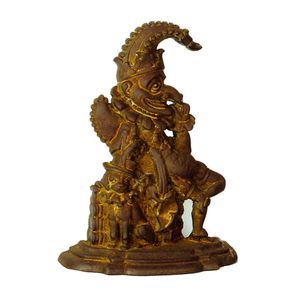Mongolian Copper Hayagriva Figure, 18th/19th Century
You must be a subscriber, and be logged in to view price and dealer details.
Subscribe Now to view actual auction price for this item
When you subscribe, you have the option of setting the currency in which to display prices to $Au, $US, $NZ or Stg.
- Attributed - A cataloguing term where the item in the opinion of the cataloguers, is a of the period of the artist, craftsman or designer, and which probably in whole or part is the work of that person.
- Embossed / Repousse - Embossing, also known as repousse, is the technique of decorating metal with raised designs, by pressing or beating out the design from the reverse side of the object.It is the opposite of chasing, where the decoration is applied from the front. An embossed or repoussed object may have chasing applied to finish off the design.
This item has been included into following indexes:
Visually similar items

A Tibetan bronze Hayagriva Vajravarahi, 20th century Hayagriva stands in pratalidhasana pose, his primary arms embrace his consort Vajravarahi, on a lotus platform, 20.5 cm high

A pair of Japanese bronze figures, late Meiji. 25 cm high (2)

Bronze Buddha figure with hands in the 'No fear' pose and sitting cross legged on detailed base, height 23 cm

An old cast iron Mr. Punch door stop, the cast figure with traditional curving tall hat, hand to long nose, his dog sits beside. Serpentine base. Height 32 cm
